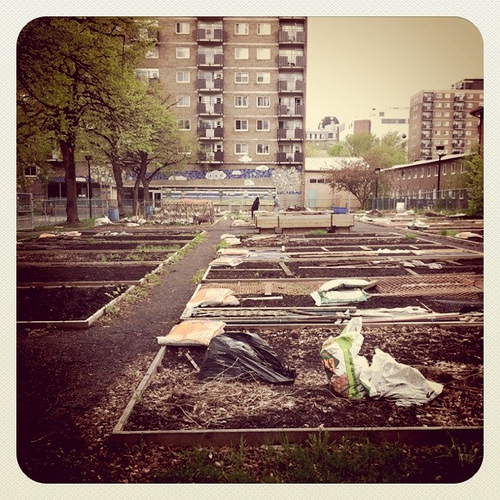This issue of whether a developer can claim public green space and build condos, apartments, stores, etc., is certainly nothing new. Cities and countries around the world deal with problems similar to these every year. Indeed, in 2007, the British government had plans to sell off some three thousand square miles of public land, including forests and moorland; the largest land deal in the United Kingdom in one hundred and fifty years. Gardens are under constant threat of relocation; if the City decides to sell the public land on which they are located or if the lease is not renewed on private land, vital green space can be up-rooted on a whim.
On private land the leases are long-term, either five or ten years, with the landowners getting tax exemptions. When located on city-owned, public land, the zoning designation can determine the future of the garden. A “park” designation ensures that land will not be sold, protecting the gardens from development. If the zoning is not “park”, then there is a possibility that the city may sell to developers. This is occurring in the Mile-End community garden where a condominium development adjacent to the garden may require additional parking space, thereby stopping the addition of fifteen new garden plots. This is also the case of the Faubourg Saint-Laurent community garden. If it closes, the city has offered to relocate the plots to Habitations Jeanne-Mance. Given that there is already a waiting list at this other location, the task of finding space for fifteen new plots is difficult. It is currently the second year of a moratorium issued by the city as they decide how to proceed with the Faubourg Saint-Laurent community garden.
Marie-Ève Chaume, specialist in public space and waste management at the Conseil Régional de l’Environnement de Montréal, feels that the uncertain future facing many gardens could be resolved by modifying the zoning to the activity. This would mean changing the zoning from residential or commercial to park if a garden is located on that land. This has already happened once in the Ville-Marie borough, so it could certainly happen again to preserve the Faubourg Saint-Laurent garden. All it takes is a commitment from the city to show that they care about community gardens in Montreal. The moratorium has given the city more time to make this decision and Chaume has positive thoughts regarding the outcome for the gardeners. She feels that they can sleep well at night knowing that they’ll be able to garden on that land for a long time. But this raises an interesting question about the garden: namely, why should anyone other than the gardeners care about the future of the Faubourg Saint-Laurent garden?
Perhaps one of the most difficult aspects of mobilizing a resistance such as this one is to convey to the broader community why the garden matters to them—essentially widening the scope of the issue. It is a crucial question and deserves attention. Why should someone who lives in Villeray, NDG or Anjou, and who does not garden, care about Faubourg Saint-Laurent? It is miles away from their neighbourhood, so why should it matter if fifty or so people don’t have a space to garden anymore? Some may choose to narrow the scope by claiming that the loss of a garden or two has little effect on the city while the development of a condo has a large effect through its stimulation of the economy. While we will not address the economic issue of bulldozing this garden, we need to ask ourselves—and “ourselves” refers to the entirety of Montreal—do we all rely on gardens and green spaces like these? And if so, how much?
Addressing these questions, Chaume responded, “I think that this garden sets a precedent. This could show how easy it is for a developer to buy collective land. [Furthermore] this is about the quality of life in Montreal. There are different citizens. There are different programs that respond to different needs and all of these needs need to be addressed and taken into consideration. The city needs to improve the environmental quality of life. Green house gasses and water issues will cost the city more when public green spaces are not a priority.”
This claim is definitely supported by many studies citing how rainwater is filtered through the garden, thus helping to keep ground and lake water clean. Studies have also shown that community gardens can use large amounts of organic waste as fertilizer, thereby reducing the community’s need for other forms of waste disposal. Furthermore, according to the City of Toronto’s Public Health and Food Policy council, community gardens are useful in providing impoverished people access to healthy fruits and vegetables. This can have wide-ranging impacts on the public health care system.
Although some express concerns about the gardens being placed on private land. However, the issue is larger than simply having a place for fifty or so people to garden. By saving the garden, we are defending the act of urban and community gardening and the principle of preserving green space in our city. It is true that the economic value of the garden in Faubourg Saint-Laurent is not greater than that of the potential condominiums, but there are substantial environmental and social costs of destroying this garden. In the area where Faubourg Saint-Laurent is located, a once heavily industrialized center (a brownfield area), pollution has been an issue for quite some time. If we let Montreal demolish this garden to build something that offers neither environmental benefits nor prospects of soil or water replenishment, the problems faced down the road will be far more environmentally significant than the economic growth of a single development company.
Montreal, Canada
 Log in
Log in









